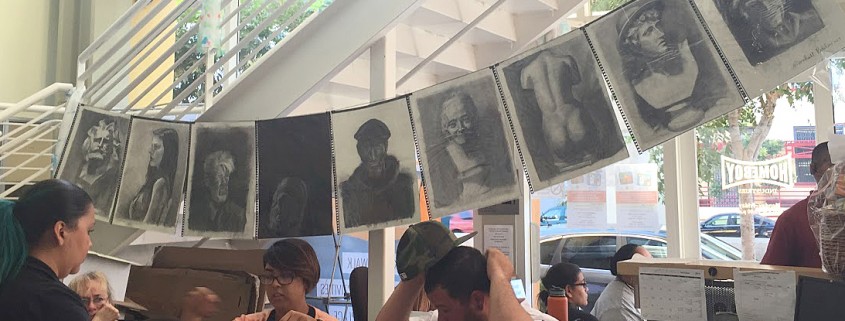Homeboy Industries supports former inmates through art show
On Oct. 10, the ninth annual “Faith and Hope: Beyond Prison Walls” art show took place in Downtown at Homeboy Industries, one of the largest gang intervention, rehabilitation and re-entry programs in the country. The program has been providing job training and therapeutic services for previously incarcerated men and women for the last 26 years. On Saturday, however, their space was transformed into a gallery with artwork from former and currently incarcerated artists.
The event was hosted by the Partnership for Re-Entry Program, a nonprofit organization that seeks ways of improving the successful reintegration of parolees back into the community. Before being released, former inmates are provided with a self-improvement modular correspondence course. Each year, PREP puts on an art show featuring not only a general viewing, but also a silent auction, a live auction and a raffle. During the live auction, there is a reading of poems, biographies and letters written by the artists. The art within the gallery ranged from crafts to paintings and jewelry, emphasizing the array of art programs within the prison complexes.
Though none of the artists featured in this year’s show were present at the event, many representatives from PREP were on the floor interacting with the viewers and giving more information on the purpose of the art show. Lucy Copp, a volunteer for PREP and a USC alumna, began working with the organization after attending last year’s art show when she moved to Los Angeles to begin her master’s degree. Her duties with PREP include reading letters from inmates, looking for transitional housing upon completion of a re-entry program and writing official letters of approval to the parole board, which grants the inmates permission to move into the transitional housing.
“When lifers, or people who are sentenced to life, receive parole to re-enter society, they have to do six months of transitional housing first, which means they can’t go directly home but have to live amongst other former inmates,” Copp said.
Without a letter of approval, these men and women cannot move out of their institutions, regardless of good conduct or re-entry programs they have participated in, so PREP has been proactive in aiding this process for inmates. Sister Mary Sean Hodges has been a pivotal force behind the organization, as she works directly with men and women at the prisons to prepare them for facing the parole board. Upon arrival, she had her hands full with every part of the exhibit and made herself available to anyone who needed assistance.
“I think [Hodges] just realized that there’s so many prisons with art programs with people doing incredible work,” Copp said. “So, why not have them send the artwork out and have people see it?”
The location of the show may have been small, but it was clear that this movement had made an impact inside and outside of the institutions. One of the volunteers for PREP is a former inmate named Gary Thomas, who now serves as the assistant director alongside Hodges. Thomas began volunteering at PREP when he was released from prison last year. Hodges was a large influence in his involvement, as she visited him in prison. Thomas knew many of the artists and people depicted in the art personally from when he was incarcerated — some for more than 30 years. His support for this artwork comes from a particular experience of knowing these men who he says live the remainder of their lives based on one mistake.
“Most of the art that you see comes from the people who have never done anything like this before in their life until they got to prison,” Thomas said. “They have tremendous talent inside because [they] learn about themselves from the inside out.”
Thomas expressed his connection to the show as a chance for people to see these artists as something outside of an act they may have committed years ago. He recounted stories of friends who have been eligible for parole but chose not to leave prison because of the media depictions of prisoners and the inability to break out of this image. Since working with PREP, the letters of support that he has written with Hodges for transitional housing have helped more than 100 inmates get released and maintain a clear record.
“If a man has done the work to learn and to better himself while he has been down, who am I to deny him help? My job is to help people,” Thomas said.
With events like the Faith and Hope art show, the volunteers of PREP sought to remove the stigma around re-entry for former inmates and create a more accepting and positive environment for people looking to make a change in their lives. As Thomas said, “Don’t judge me by my past. I don’t live there anymore.”

